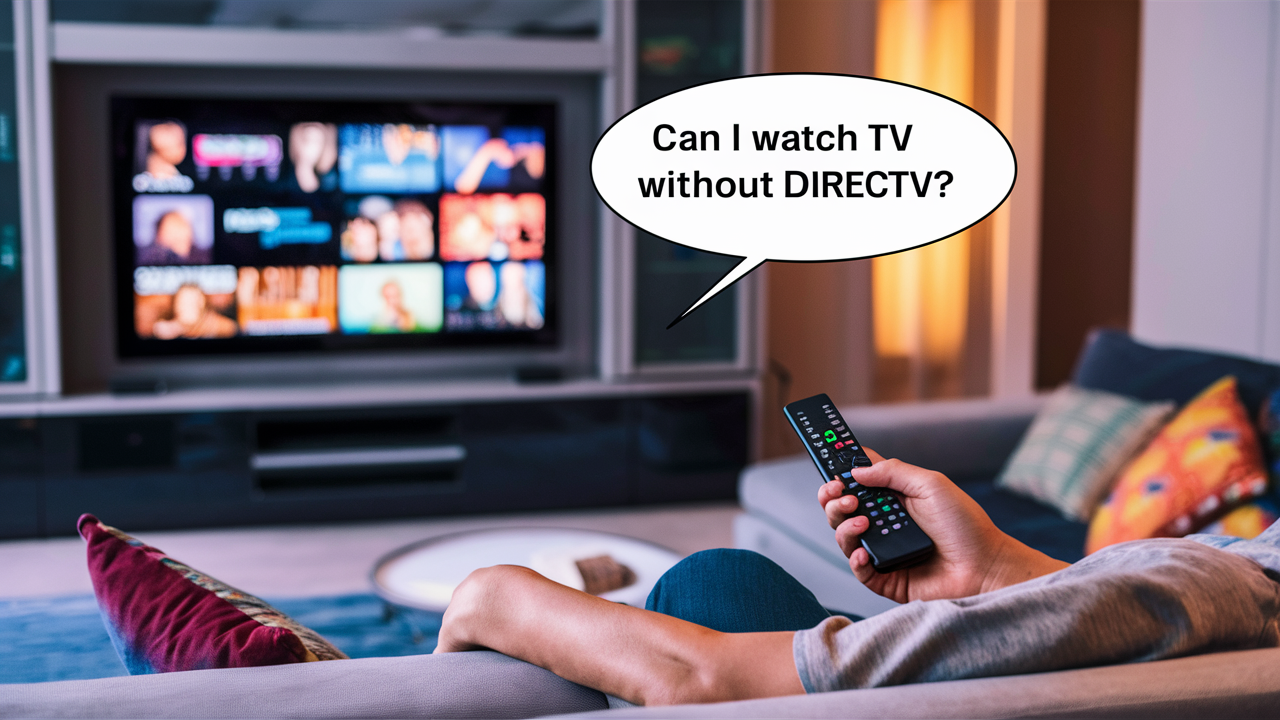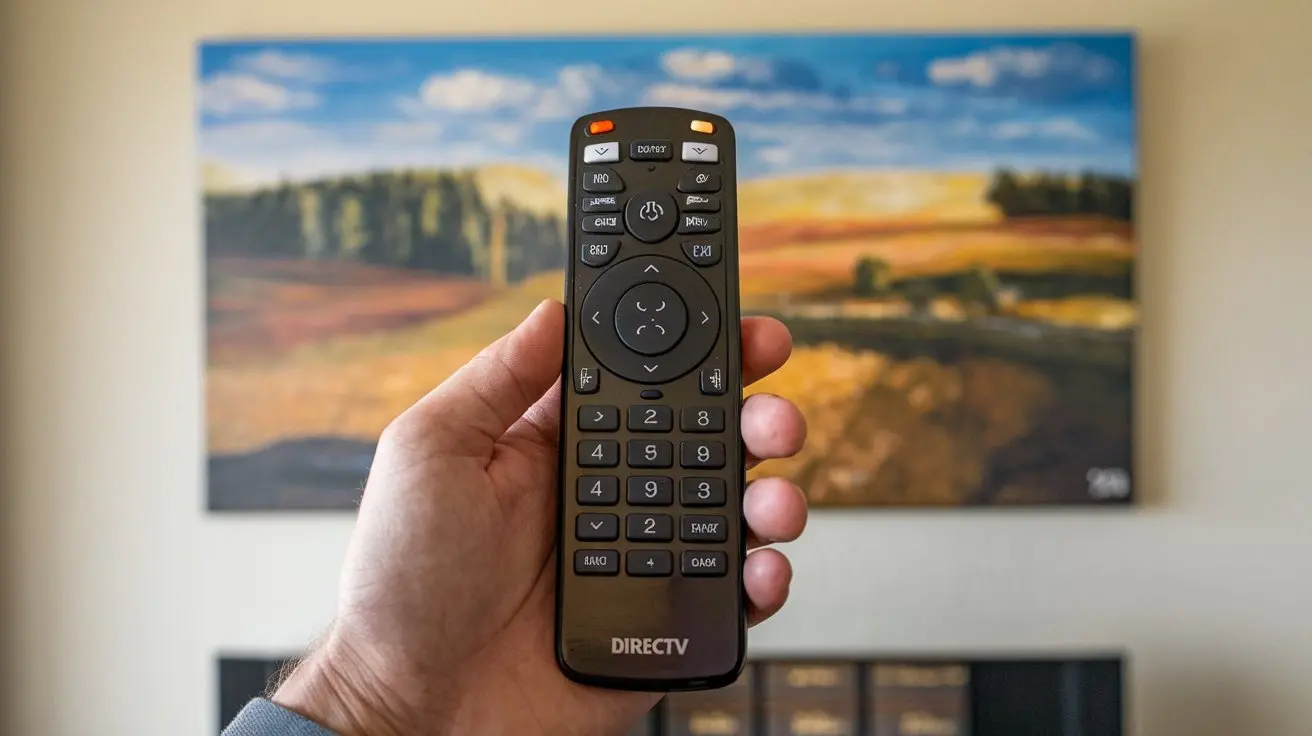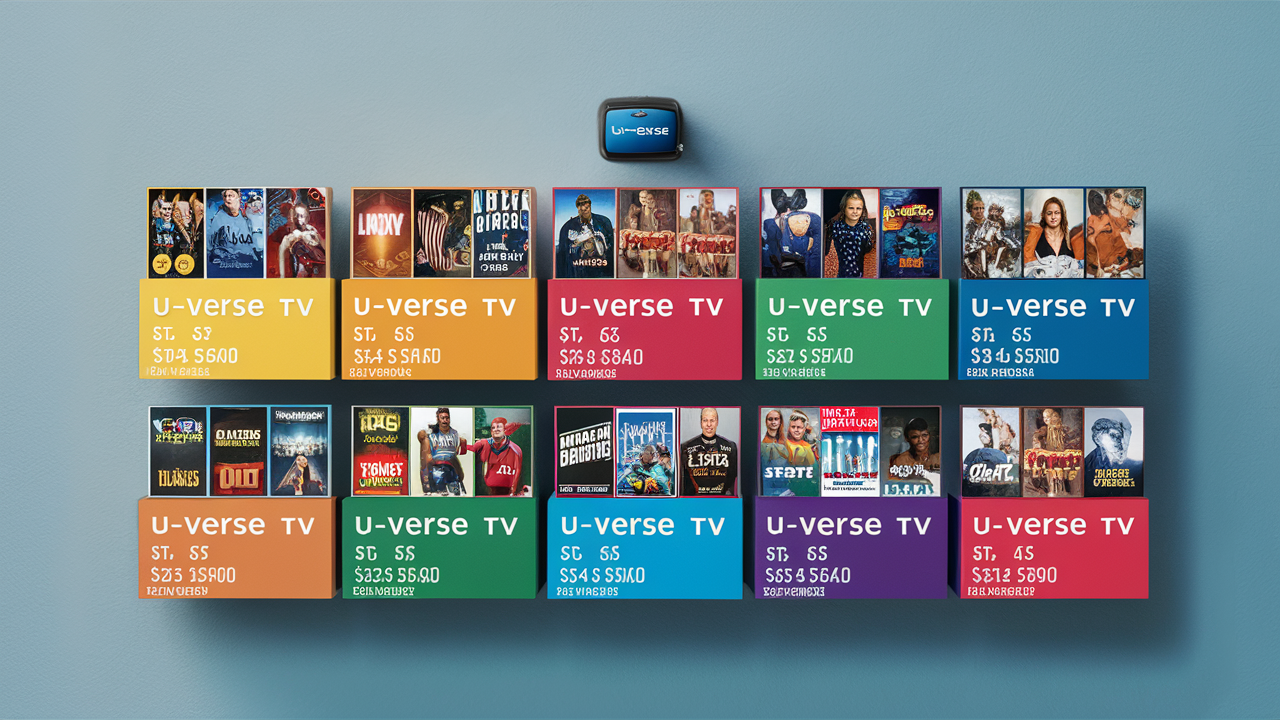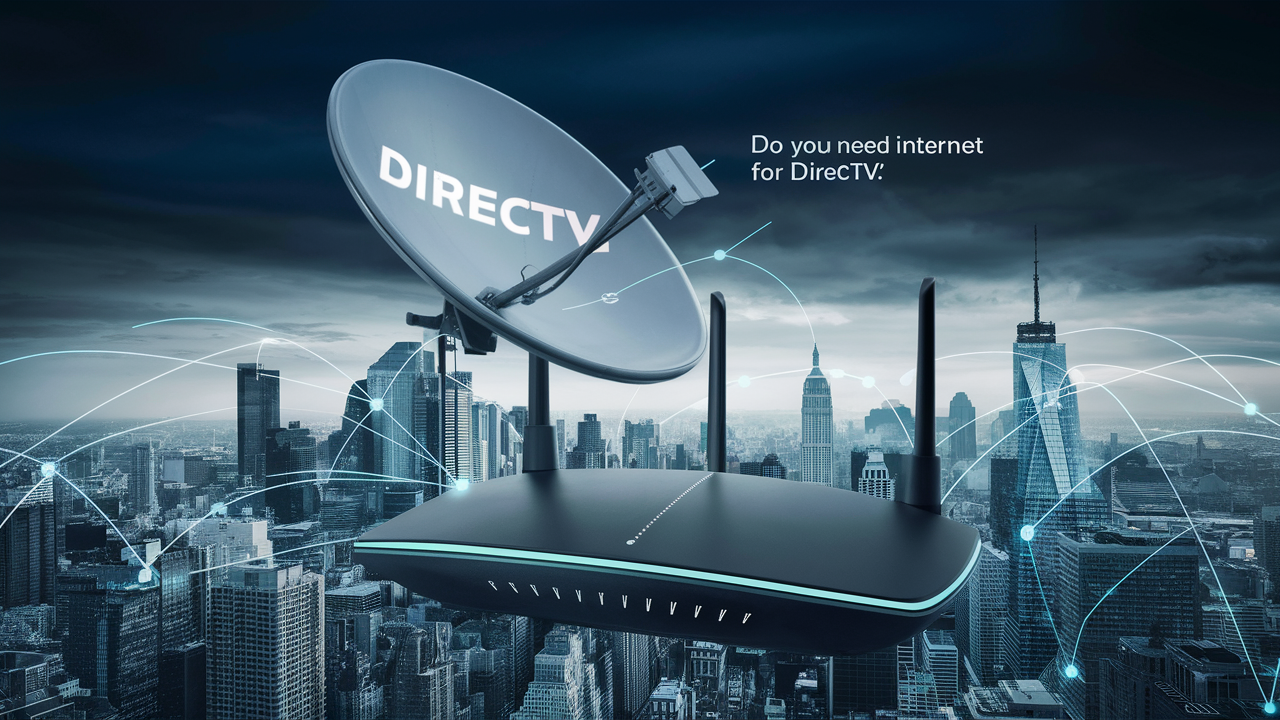Can I watch TV without DIRECTV?

Absolutely! The landscape of television viewing has dramatically shifted, offering a plethora of ways to enjoy your favorite shows and live events without a traditional DIRECTV subscription. You can access a vast array of content through streaming services, over-the-air antennas, and other innovative platforms, making it easier than ever to cut the cord.
Understanding the "Cord-Cutting" Phenomenon
The term "cord-cutting" refers to the act of canceling or foregoing traditional cable or satellite television subscriptions, like DIRECTV, in favor of internet-based alternatives. This trend has accelerated significantly over the past decade, driven by a desire for more flexibility, lower costs, and access to a wider variety of content on demand. In 2025, the reasons for cord-cutting are more compelling than ever. Consumers are increasingly frustrated with the rising prices of bundled cable packages, which often include channels they never watch. Furthermore, the rise of high-speed internet has made streaming services a viable and often superior alternative for accessing live and on-demand entertainment. This shift isn't just about saving money; it's about regaining control over what you watch, when you watch it, and how much you pay for it. The ability to customize your entertainment package, without being tied to long-term contracts or paying for unwanted channels, is a powerful draw for millions.
Streaming Services: The Primary Alternative
Streaming services have become the undisputed champions of the cord-cutting movement. They offer a diverse range of content, from live news and sports to binge-worthy series and blockbuster movies, all accessible via an internet connection. The market is vast and continues to evolve, with new players emerging and established ones constantly updating their offerings. Understanding the different types of streaming services is key to building a personalized TV-watching experience.
Live TV Streaming Services
For those who still want the experience of live television, including news, sports, and current events as they happen, live TV streaming services are the closest alternative to traditional cable or satellite. These services aggregate channels from various networks and deliver them over the internet. They often mimic the channel lineups of traditional providers but with the added benefits of flexibility and often lower costs.
Popular Live TV Streaming Services in 2025:
- YouTube TV: Known for its extensive channel selection, including major sports networks like ESPN and regional sports networks, as well as local channels in most markets. It also boasts unlimited cloud DVR storage. In 2025, YouTube TV continues to be a top contender for its comprehensive offering and user-friendly interface. Its base plan typically includes over 85 channels.
- Hulu + Live TV: This service combines Hulu's massive on-demand library with live TV channels. It's a great option for those who want both live programming and a robust selection of original series and movies. In 2025, Hulu + Live TV offers a compelling bundle, often including Disney+ and ESPN+ at no extra cost, making it a value proposition for many households. The channel count often exceeds 75.
- Sling TV: Sling TV offers a more customizable approach with its "Orange" and "Blue" base packages, which can be combined. Users can then add "Extras" for specific interests like sports, comedy, or kids' programming. This makes it a more budget-friendly option for those who want specific channels rather than a broad bundle. Sling's flexibility is a key selling point in 2025, allowing users to tailor their subscriptions precisely.
- FuboTV: Originally focused on sports, FuboTV has expanded its offerings to include a wide array of entertainment and news channels. It's particularly appealing to sports enthusiasts due to its extensive sports channel lineup, including international soccer leagues. In 2025, FuboTV remains a strong choice for sports fans, offering a vast selection of live sporting events.
- DirecTV Stream: While the name might suggest a connection to DIRECTV, DirecTV Stream is an internet-based service that offers various channel packages, including options with RSNs (Regional Sports Networks) and premium channels. It's a more premium offering in the live TV streaming space.
The cost of these services in 2025 typically ranges from $50 to $90 per month, depending on the provider and the package chosen. This is often significantly less than the average DIRECTV package, especially when you factor in equipment rental fees and other hidden charges that traditional providers sometimes impose.
On-Demand Streaming Services
These are the services that have truly revolutionized home entertainment. Instead of a fixed schedule, you can watch what you want, when you want, on virtually any internet-connected device. They are characterized by vast libraries of movies, TV shows, documentaries, and original content.
Major On-Demand Streaming Services in 2025:
- Netflix: The pioneer and still a giant in the streaming world, Netflix offers a massive library of licensed content and a growing slate of critically acclaimed original series and films. Its personalized recommendation engine is a key feature.
- Max (formerly HBO Max): Combining content from HBO, Warner Bros., DC, Discovery, and more, Max offers a premium experience with prestige television, blockbuster movies, and a wealth of documentary content. Its integration of Discovery+ content has broadened its appeal.
- Disney+: The go-to service for Disney, Pixar, Marvel, Star Wars, and National Geographic content. It's a must-have for families and fans of these iconic franchises.
- Amazon Prime Video: Included with an Amazon Prime subscription, this service offers a good mix of popular movies and TV shows, alongside a growing number of critically acclaimed original productions. It also allows for add-on channels.
- Apple TV+: While its library is smaller, Apple TV+ focuses on high-quality, star-studded original content, including award-winning shows and films.
- Paramount+: Features content from CBS, Paramount Pictures, Showtime (with an add-on), and original series.
- Peacock: NBCUniversal's streaming service, offering a mix of current NBC shows, classic movies, and original content.
The cost for these services varies, generally ranging from $5 to $20 per month per service. Many users subscribe to a combination of these services to curate their ideal entertainment library. For example, a common setup in 2025 might include Netflix for general entertainment, Disney+ for family content, and Max for prestige dramas and movies.
Niche and Specialty Streaming
Beyond the major players, a plethora of niche streaming services cater to specific interests. These can be invaluable for viewers with particular hobbies or tastes.
- Sports: Services like ESPN+ (often bundled with Hulu), MLB.TV, NBA League Pass, and NHL.TV offer dedicated coverage for specific sports leagues. FuboTV also excels here.
- Anime: Crunchyroll is the dominant platform for anime fans, offering a vast library of series and films.
- Documentaries: CuriosityStream provides an extensive collection of documentaries on a wide range of subjects.
- Acorn TV / BritBox: For fans of British television, these services offer a curated selection of British dramas, comedies, and mysteries.
- Shudder: The go-to for horror movie enthusiasts.
These services often cost between $5 and $15 per month. By strategically combining a live TV streaming service with a few select on-demand and niche services, users can build a comprehensive entertainment package that rivals, and often surpasses, traditional cable offerings, all without a DIRECTV subscription.
Choosing the Right Streaming Plan
The key to a successful cord-cutting strategy is careful planning and selection. Here’s a step-by-step approach to choosing the right streaming plans in 2025:
- Identify Your Must-Watch Content: What channels, shows, or sports leagues are non-negotiable for you and your household? List them out.
- Check Channel Availability: Use resources like Suppose.tv (a third-party tool that helps compare services) or the providers' own websites to see which services carry your essential channels. Pay close attention to local channel availability (ABC, CBS, NBC, FOX) and regional sports networks.
- Consider Your Budget: Determine how much you're willing to spend per month. Remember to factor in the cost of internet service, which is essential for streaming.
- Evaluate On-Demand Needs: Do you prefer binge-watching series, watching new movie releases, or exploring documentaries? Choose on-demand services that align with your viewing habits.
- Read Reviews and Trial Periods: Most streaming services offer free trial periods. Take advantage of these to test out the interface, channel selection, and overall user experience before committing. Read current reviews from 2025 to get the latest insights.
- Bundle Wisely: Look for bundles that offer savings, such as the Disney+/Hulu/ESPN+ bundle or packages that include premium channels.
By following these steps, you can construct a personalized streaming lineup that meets your entertainment needs without the commitment and cost of DIRECTV.
Over-the-Air (OTA) Antennas: A Free Option
For a significant portion of your television viewing, an Over-the-Air (OTA) antenna can provide a completely free and surprisingly robust solution. This technology leverages broadcast signals that are transmitted through the air, much like radio waves, and can be picked up by a simple antenna connected to your TV.
How OTA Antennas Work
In the United States, local television stations broadcast their signals digitally over the air. These signals are free for anyone to receive within a certain range. An OTA antenna acts as a receiver, capturing these digital signals. Modern smart TVs often have built-in tuners that can process these signals, allowing you to watch the channels directly. For older TVs, a digital converter box can be used to translate the digital signals into a format the TV can display. The quality of the signal received depends on factors like your geographic location, the distance to the broadcast towers, and any obstructions (like buildings or hills) in the signal path.
What Channels Can You Get with OTA?
OTA antennas primarily provide access to local broadcast channels. In most metropolitan areas, this includes the major networks: ABC, CBS, NBC, FOX, and PBS. Many of these networks also offer additional subchannels that broadcast different programming. For example, a single NBC station might broadcast its main programming on channel 4.1, a 24/7 news channel on 4.2, a classic TV channel on 4.3, and a shopping channel on 4.4. This means that what might appear to be just a few channels can actually be dozens of distinct programming streams. In 2025, the number and variety of subchannels continue to grow, offering more diverse content, including retro shows, foreign language programming, and niche interest channels.
The exact channels available will vary by location. You can use online tools like the FCC's DTV Reception Maps to see which channels are available in your specific area. This is a crucial step before investing in an antenna.
Types of OTA Antennas
OTA antennas come in various forms, designed for different needs and installation locations:
- Indoor Antennas: These are compact and designed to be placed on a windowsill, shelf, or mounted on a wall inside your home. They are convenient and easy to set up but may offer weaker reception, especially if you are far from broadcast towers. Small, flat panel antennas are very popular for their discreet design.
- Outdoor Antennas: Mounted on a roof, pole, or side of the house, outdoor antennas are generally more powerful and can receive signals from further away. They are ideal for rural areas or locations with weaker signal strength. These can range from smaller directional antennas to large multi-directional "bowtie" style antennas.
- Attic Antennas: A compromise between indoor and outdoor, these are mounted in the attic. They offer better reception than most indoor antennas while remaining hidden from view.
When choosing an antenna, consider its reception range (how far it can pick up signals) and its directionality (whether it's designed to receive signals from a specific direction or multiple directions). Many modern antennas are multi-directional, offering greater flexibility.
Setting Up Your OTA Antenna
Setting up an OTA antenna is generally straightforward:
- Connect the Antenna: Plug the coaxial cable from the antenna into the "Antenna In" or "RF In" port on your TV or converter box.
- Position the Antenna: For indoor antennas, experiment with different locations – near a window, on a high shelf, or facing the direction of the broadcast towers. For outdoor antennas, proper mounting and aiming are crucial.
- Scan for Channels: Navigate to your TV's menu and find the "Channel Scan," "Auto Tune," or "Program Channels" option. Select "Antenna" or "Air" as the source. The TV will then search for and store all receivable channels.
- Fine-Tune: If you're not getting all the channels you expect, try repositioning the antenna and rescanning. For outdoor antennas, professional installation might be beneficial if you're struggling with reception.
The cost of OTA antennas can range from $20 for basic indoor models to $100 or more for high-gain outdoor antennas. However, once purchased, the channels are entirely free, making it a highly cost-effective solution in 2025 for accessing local news and programming.
Other Ways to Watch TV Without DIRECTV
Beyond the dominant forces of streaming and OTA broadcasting, several other avenues exist for enjoying television content without a traditional subscription.
Internet TV and IPTV
IPTV (Internet Protocol Television) is a broad term that refers to television delivered over the internet. While this technically encompasses all streaming services, the term is sometimes used to refer to services that offer live TV channels via custom apps or platforms, often outside the mainstream providers. It's crucial to distinguish between legitimate IPTV services and illegal ones. Many legitimate IPTV providers offer packages of live channels for a monthly fee, often at a lower price point than traditional cable. However, users must exercise caution and ensure they are subscribing to legal and reputable services to avoid potential legal issues and unreliable streams.
Some smart TVs and streaming devices also offer access to a variety of free, ad-supported streaming channels through apps like Pluto TV, Tubi, and The Roku Channel. These services aggregate content from various sources and present it in a channel-like format, offering a lean-back viewing experience similar to traditional TV but without a subscription fee. In 2025, these free services are becoming increasingly sophisticated and offer a surprisingly broad selection of movies and TV shows.
Gaming Consoles and Smart TV Apps
Modern gaming consoles like the PlayStation and Xbox, as well as smart TVs from brands like Samsung, LG, and Vizio, are essentially powerful media hubs. They come pre-loaded with or allow you to download apps for all the major streaming services mentioned earlier (Netflix, Hulu, Max, Disney+, etc.). This means you can use your existing gaming console or smart TV to access your entire streaming library, eliminating the need for separate streaming sticks or boxes for many users. Furthermore, many consoles offer their own live TV streaming apps or integrations, further consolidating your entertainment options.
Public Libraries and Community Resources
While not a primary method for live TV viewing, public libraries offer a wealth of entertainment options that can supplement your viewing habits. Many libraries provide access to streaming services like Kanopy or Hoopla, which offer a curated selection of films, documentaries, and educational content for free with a library card. These services are excellent for discovering independent films, classic cinema, and in-depth documentaries without any additional cost. In 2025, the digital offerings of public libraries are more robust than ever, making them a valuable, often overlooked, resource for entertainment.
Combining Different Methods for a Complete Solution
The most effective way to watch TV without DIRECTV in 2025 is often by combining several of these methods. This approach allows you to tailor your entertainment to your specific needs and budget, ensuring you never miss out on what you want to watch.
Consider this common strategy:
- Local Channels: Use an OTA antenna to get all your local news, network shows, and major sporting events for free. This is the foundation for many cord-cutters.
- Live Sports & News: Subscribe to a live TV streaming service like YouTube TV or Hulu + Live TV for a comprehensive selection of national and regional sports channels, breaking news, and a wider variety of entertainment channels. Choose a plan that offers the specific sports leagues or news outlets you follow.
- On-Demand Binge-Watching: Subscribe to a few key on-demand services like Netflix, Max, and Disney+ for your favorite series, movies, and family content. Rotate subscriptions if you only need certain content for a limited time.
- Specialty Content: Add niche services like ESPN+ for additional sports coverage or a service like Crunchyroll if you're an anime fan.
- Free Entertainment: Utilize free ad-supported services like Pluto TV or Tubi for casual viewing, movies, and shows you might have missed.
This layered approach ensures you have access to live events, on-demand libraries, and free content, all while maintaining flexibility and controlling costs. For example, a household might pay $65/month for YouTube TV, $15/month for Netflix, and $13/month for Disney+. This totals $93/month, which is often less than a comparable DIRECTV package, and provides a far more customizable and modern viewing experience. The key is to regularly review your subscriptions and adjust them based on your current viewing habits.
Cost Comparison: 2025 Edition
The financial aspect is a major driver for cord-cutting. Let's break down typical costs in 2025:
| Service Type | Typical Monthly Cost (USD) | Notes |
|---|---|---|
| DIRECTV (Example Package) | $90 - $180+ | Varies greatly by package, often includes fees for equipment, regional sports, etc. |
| Live TV Streaming (e.g., YouTube TV, Hulu + Live TV) | $50 - $90 | Includes local channels, sports, news, entertainment. Unlimited DVR common. |
| On-Demand Streaming (e.g., Netflix, Max, Disney+) | $5 - $20 (per service) | Many users subscribe to 2-3 services. Bundles can offer savings. |
| Niche Streaming (e.g., ESPN+, Crunchyroll) | $5 - $15 (per service) | For specialized interests. |
| OTA Antenna | $20 - $100 (one-time purchase) | Provides free local channels indefinitely. |
| Free Ad-Supported Streaming (e.g., Pluto TV, Tubi) | $0 | Content supported by advertisements. |
As the table illustrates, a customized streaming setup can be significantly cheaper than a traditional DIRECTV subscription. For instance, a user subscribing to YouTube TV ($65/month), Netflix ($15/month), and Disney+ ($13/month), plus using an OTA antenna, would spend approximately $93/month. This provides a broader selection of content and greater flexibility than many DIRECTV packages in the same price range. The ability to cancel or add services month-to-month also offers unparalleled financial control.
Conclusion: Your TV Viewing Future
The question "Can I watch TV without DIRECTV?" is definitively answered with a resounding yes. The era of being tethered to a single, expensive cable or satellite provider is largely over. In 2025, a vibrant ecosystem of streaming services, free over-the-air broadcasts, and innovative platforms empowers viewers to curate their own entertainment experiences. Whether you prioritize live sports, binge-worthy dramas, family-friendly content, or free local news, there is a cost-effective and flexible solution available. By understanding your viewing habits, exploring the diverse options, and strategically combining services like live TV streamers, on-demand platforms, and OTA antennas, you can build a superior TV-watching setup that saves you money and puts you in complete control. Embrace the freedom of cord-cutting and step into a future of personalized, accessible, and affordable television.





